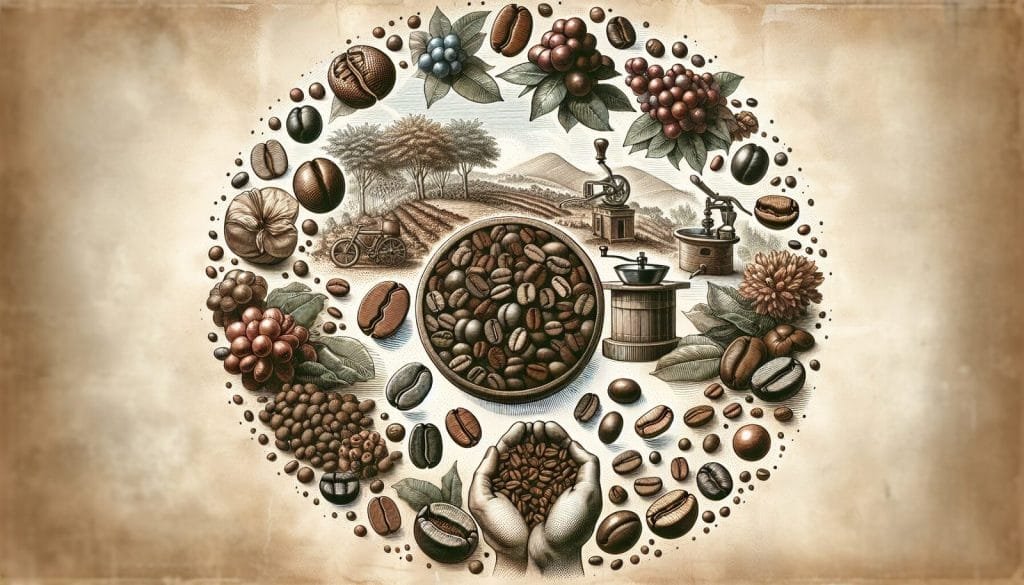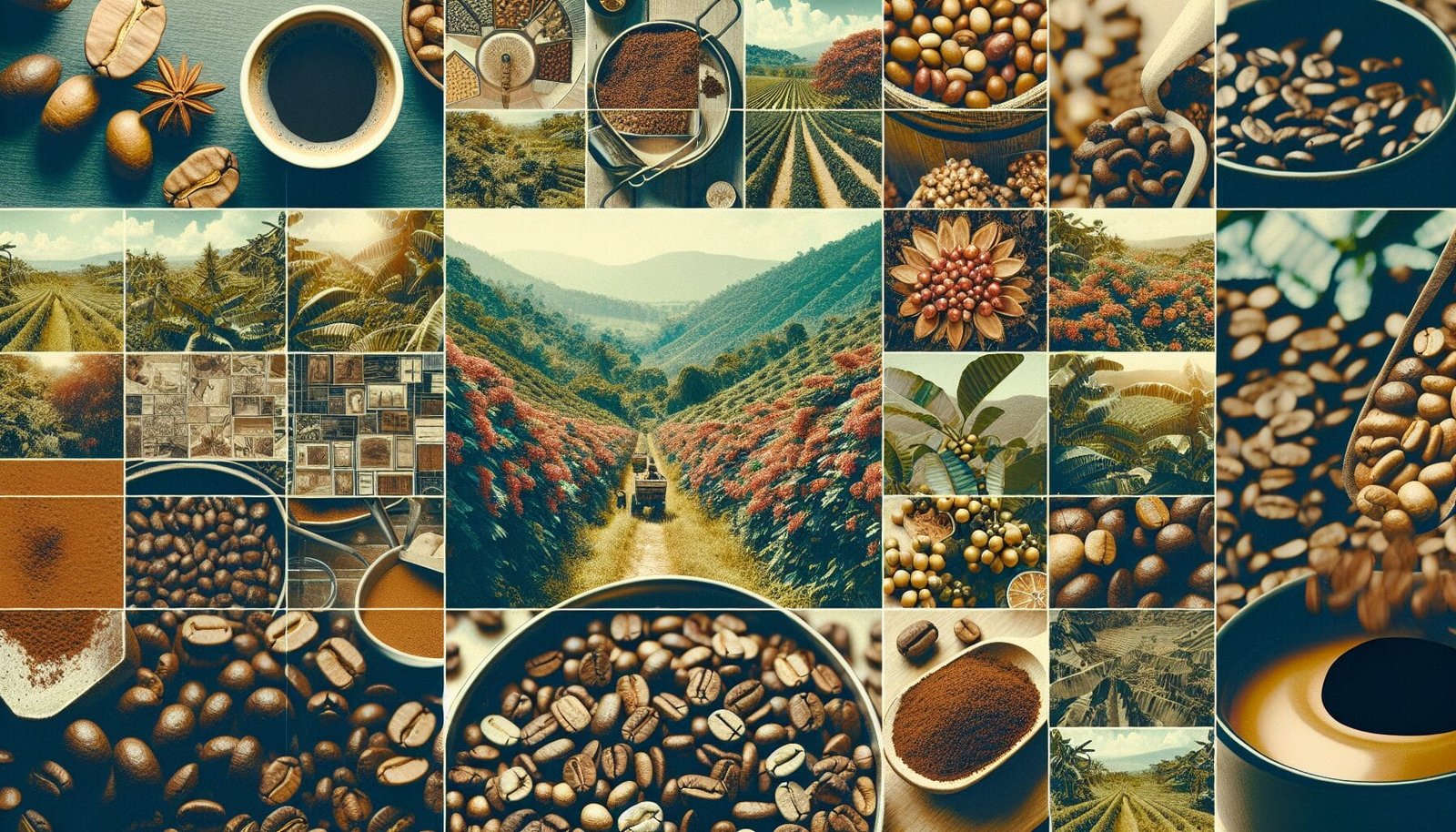You’ve probably heard of Coffee beans, those magical little seeds that give us that much-needed jolt of caffeine in the morning. But have you ever wondered what these beans are actually called? In this article, we’ll reveal the mysterious name behind these beloved beans and explore the fascinating world of coffee. So grab your mug and get ready to uncover the secret behind one of the world’s most beloved beverages.
Bean Varieties
When you think about coffee, you may not realize that the rich, delicious drink is actually made from beans. Coffee beans are the seeds of the coffee plant and they come in different varieties with unique characteristics. In this article, we will explore the different types of coffee beans and delve into their descriptions, origins, taste profiles, cultivation, and processing methods.
Arabica Beans
Arabica beans are often considered the crème de la crème of coffee beans. They are known for their delicate flavors and aromatic qualities, making them highly sought after by coffee connoisseurs all over the world.
Description
Arabica beans have an elongated shape and a slight curve, with a groove running along their sides. They are usually larger and flatter compared to other bean varieties, giving them a distinct appearance. The beans also have a pale green color, which turns darker as they mature.
Origins
Arabica beans have their origins in the high-altitude regions of Ethiopia, where they were first discovered centuries ago. Today, they are grown in various parts of the world, including Central and South America, Africa, and Asia.
Taste Profile
When it comes to taste, Arabica beans offer a wide range of flavors. They can have notes of chocolate, berries, citrus, caramel, and even floral undertones. Arabica coffee is often described as smooth, well-balanced, and with a pleasant acidity that adds brightness to the cup.
Cultivation and Processing
Arabica coffee plants require specific growing conditions to thrive. They prefer higher altitudes, cooler temperatures, and shade. The cultivation process involves careful nurturing of the plants, including regular pruning and protection from pests and diseases. Once the cherries are ripe, they are hand-picked and undergo a meticulous processing method, which can vary depending on the region and traditions. This includes pulping, fermenting, washing, and drying the beans.
Robusta Beans
Robusta beans may not have the same level of prestige as Arabica beans, but they certainly have their own distinct qualities that make them popular in the coffee industry.
Description
Robusta beans are smaller and rounder compared to Arabica beans, with a straighter shape. They also have a harder texture and a higher caffeine content, attributing to their robust name.
Origins
Robusta beans originally come from the lowland regions of West and Central Africa, where they were discovered in the late 19th century. Today, they are primarily grown in Africa, Vietnam, and Brazil.
Taste Profile
Robusta beans are known for their strong and bitter flavors. They often have earthy, nutty, and even woody notes, with a higher level of acidity compared to Arabica beans. Due to their robust flavor profile, they are commonly used in espresso blends to provide a strong kick.
Cultivation and Processing
Robusta coffee plants are more resilient and can withstand harsher climates and pests, making them easier to cultivate compared to Arabica plants. They are usually grown at lower altitudes and require less shade. After the cherries are harvested, they undergo a simple processing method, which typically involves drying the beans in the sun or using mechanical dryers.
Liberica Beans
Liberica beans are considered a rare and unique coffee variety, with a distinct flavor profile that sets them apart from others.
Description
Liberica beans are the largest among the coffee bean varieties, with an asymmetrical shape. They have a rugged appearance, with an uneven surface and a deep groove. The beans also have a unique aroma that is often described as floral or fruity.
Origins
Liberica beans were first discovered in Liberia, West Africa, giving them their name. However, they are now mainly grown in the Philippines, which is the largest producer of Liberica coffee in the world.
Taste Profile
Liberica beans offer a bold and somewhat smoky flavor, with hints of wood and a slightly floral aftertaste. They have a low acidity level, making them popular among those who prefer a milder coffee taste.
Cultivation and Processing
Liberica coffee plants require specific growing conditions, including warm temperatures and well-drained soils. They are typically grown at lower altitudes and do not require as much shade. The processing methods for Liberica beans are similar to those used for Arabica beans, including pulping, fermenting, washing, and drying.
Excelsa Beans
Excelsa beans are a lesser-known variety that often gets overshadowed by Arabica and Robusta. However, they have their own unique characteristics that make them worth exploring.
Description
Excelsa beans have a similar appearance to Liberica beans, with an asymmetrical and elongated shape. They are smaller than Liberica beans but larger than Arabica and Robusta beans. They also have a deep groove and a smooth surface.
Origins
Excelsa beans are believed to have originated in Southeast Asia, particularly in countries like Vietnam and the Philippines. They are primarily grown in these regions today.
Taste Profile
The flavors of Excelsa beans are often described as complex and exotic. They can have fruity, tart, and even spicy notes, with a distinctive tartness that sets them apart from other coffee bean varieties.
Cultivation and Processing
Excelsa coffee plants require similar growing conditions as other coffee varieties, with warm temperatures and well-drained soils. They are usually grown at lower altitudes and can tolerate slightly more shade. The processing methods for Excelsa beans are similar to Arabica beans, involving pulping, fermenting, washing, and drying.
Other Coffee Bean Varieties
Apart from the main four coffee bean varieties, there are several other types that offer unique flavors and characteristics. Let’s explore some of these varieties:
Maragogype
Maragogype beans are known for their extraordinary size, often referred to as “elephant beans.” They have a lower yield compared to other varieties, but their flavor profile is worth the extra effort. Maragogype beans typically have a milder acidity and a rich, complex taste.
Peaberry
Peaberry beans are a special type of coffee bean that forms as a single, round seed instead of the usual two halves. This unique formation results in a more concentrated flavor, often described as intense and vibrant. Peaberry beans are found in both Arabica and Robusta varieties.
Catimor
Catimor beans are a crossbreed between Caturra and Hybrido de Timor varieties. They were developed to be resistant to certain coffee diseases, making them popular among farmers. Catimor beans typically have a more bitter flavor with earthy undertones.
Typica
Typica beans are one of the original coffee varieties that have been cultivated for centuries. They are known for their delicate flavors and low acidity. Typica beans have an elongated shape and are usually grown at high altitudes, producing a distinct flavor profile.

Coffee Bean Characteristics
Coffee beans, regardless of their variety, share common characteristics that contribute to the overall quality and flavor of the brewed coffee. Let’s explore these characteristics:
Size and Shape
Coffee beans can vary in size and shape, which often indicates their variety. Larger beans like Liberica and Maragogype are believed to have a more developed flavor profile, while smaller beans like Robusta and Excelsa tend to have a stronger and more concentrated taste.
Color
The color of coffee beans can range from pale green to deep brown, depending on their degree of roasting. Lighter roasts generally have a lighter color and milder flavors, while darker roasts have a deeper color and more intense flavors.
Density
The density of coffee beans affects how they interact with water during brewing. Beans with higher density tend to extract more slowly, resulting in a more nuanced and flavorful cup of coffee. Arabica beans are known for their higher density compared to other varieties.
Aroma
The aroma of coffee beans is an essential factor in determining the overall coffee experience. Different varieties offer distinct aroma profiles, ranging from fruity and floral to nutty and chocolatey. The aroma gives a preview of the flavors you can expect from a particular coffee bean.
Harvesting and Processing
Once the coffee cherries are ripe, they need to be carefully harvested and processed to ensure the best quality beans. Let’s explore the harvesting and processing methods:
Picking
Picking coffee cherries is a labor-intensive process that involves selectively picking only the ripe cherries. This is usually done by hand to avoid damaging the unripe or overripe cherries. The selective picking ensures that only the highest quality beans make it into the final product.
Processing Methods
After harvesting, the coffee cherries go through a series of processing methods to remove the outer layers and extract the beans. These methods can vary depending on the region and traditions. Processing methods include pulping, fermenting, washing, and drying. Each method contributes to the flavor and characteristics of the final coffee.
Roasting
Roasting is a crucial step that transforms the green coffee beans into the aromatic and flavorful beans we know and love. The roasting process involves applying heat to the beans, causing chemical reactions that develop the unique flavors and aromas. Roasting times and temperatures can be adjusted to achieve different roast levels, ranging from light to dark.

Grinding and Brewing
To unleash the full potential of the coffee beans, they need to be properly ground and brewed. Let’s explore the grinding and brewing methods:
Bean Grinding
Grinding coffee beans just before brewing ensures the freshest and most flavorful cup of coffee. The grind size can vary depending on the brewing method. Finer grinds are suitable for espresso machines, while coarser grinds are better for methods like French press or pour-over. The grind size affects the extraction process and ultimately the taste of the brewed coffee.
Coffee Brewing Methods
There are various ways to brew coffee, each offering a unique taste profile and brewing experience. Some popular brewing methods include espresso, French press, pour-over, and cold brew. The choice of brewing method depends on personal preference and the desired flavors and characteristics of the coffee.
Conclusion
Coffee beans are the heart and soul of the beloved beverage we all enjoy. Each variety of coffee bean offers its own unique characteristics, flavors, and origin stories. From the delicate and aromatic Arabica beans to the strong and bitter Robusta beans, there is a coffee bean variety to suit every taste preference. Understanding the different coffee bean varieties, their origins, cultivation methods, and taste profiles allows us to appreciate the nuances and complexities of coffee even more. So next time you sip on a delicious cup of coffee, take a moment to appreciate the journey of those little beans that brought you so much joy and satisfaction.




